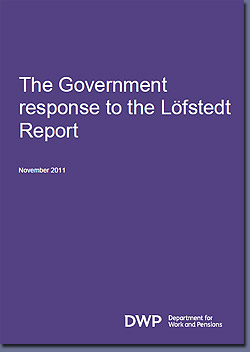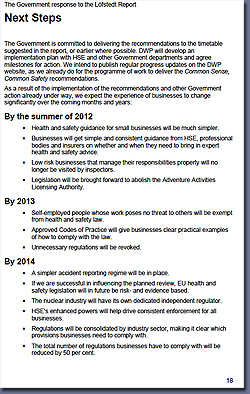Government Response To Löfstedt Review Confirms No Policy Change On Health and Safety
In case anyone is under the false impression that Professor Löfstedt’s review into health and safety legislation is the final act of this Tory-led Con-Dem(ned) attack on health and safety; the Government’s response to the review makes sobering reading.
Further, the Red Tape Challenge website is alive and well, and the comments being under the health and safety section made up until January 2012 at least; will be used to inform further Government changes to the Health and safety regime of this country. This is made clear on page 8 of the response document:
“The Red Tape Challenge process complements Professor Löfstedt review. Comments relating to health and safety regulations made on the Red Tape Challenge website up to 28 July were considered by Professor Löfstedt alongside responses to his call for evidence. Comments made after 28 July are being considered by HSE as part of the Government’s ongoing commitment to regulatory reform.”
 The introduction to the Government’s response document once again, despite there being no evidence to support its existence, as confirmed in the Löfstedt review; continues to talk of the ‘compensation culture’:
The introduction to the Government’s response document once again, despite there being no evidence to support its existence, as confirmed in the Löfstedt review; continues to talk of the ‘compensation culture’:
“From the outset, we recognised that legislation was only one part of the problem. We have therefore announced a series of measures that also cover how the law is enforced and the wider structures that support and incentivise the compensation culture.”
It goes further by reminding us of the Government’s acceptance in total of Lord Young’s findings, and his recommendations for change, which were published in October 2010 in his report Common Sense, Common Safety.
But the true intention of the Government puts the Löfstedt Review into perspective and indicates that the review changes absolutely nothing of the Government’s intentions to decimate health and safety legislation and practice in the UK:
“The recommendations covered a wide range of issues including legislation, enforcement, the role of insurers and compensation claims procedures. The review recommended a general consolidation of health and safety regulations, which formed part of the remit of Professor Löfstedt’s review.
The Government accepted Lord Young’s report and recommendations in full. At the Prime Minister’s request, in February 2011 the Minister for Employment took overall lead on implementation, ensuring robust plans for delivery are in place, and overseeing progress.
Since March DWP has published regular updates detailing the progress that has been made in delivering Lord Young’s recommendations, and one year on from publication 16 of 35 of those recommendations have been implemented…”
Further reading of the 19 page document gives only a rough guide to what the government has in store for those concerned about the health and safety protection of workers.
As expected, they pick and choose the bits of the review to suit their aims, and ignore the evidence to the contrary.
In brief, the Government’s response document highlights the following recommendations from Professor Löfstedt’s review it wishes to implement without delay:
* The Government will ask HSE to take urgent action to draw up proposals for changing the law to remove health and safety burdens from the self employed in low-risk occupations, whose activities represent no risk to other people.
* The Government will ask the HSE to review its 53 Approved Codes of Practice (ACoPs), to the timetable recommended by Professor Löfstedt.
* Professor Löfstedt has identified a number of areas where there is the potential to consolidate health and safety regulations – many of which are quite old and may not reflect the best way of delivering the desired outcomes now given changes in industry and society.
The aim is not to remove vital protections but to ensure that regulations reflect contemporary approaches to risk management and control, focus on real risks, and make it easier for employers to understand and therefore meet their obligations. Through implementing the recommendations of the report, and ongoing HSE plans, we will reduce the number of health and safety regulations by more than 50 per cent without reducing the protection offered to employees and the public.
* There are a number of regulations that apply to specific sectors only which would benefit from consolidation. The body of regulation related to these areas has built up over the years, resulting in an often fragmented and complex set of requirements. The Professor specifically mentions explosives, mining, genetically modified organisms, petroleum, and biocides but acknowledges that there may be further areas which could be considered.
* We will work with local government to improve the quality of training and dispel myths and the fear of litigation, which is why many councils can be over-cautious with their inspections.
 The final actions listed has the potential to be extremely detrimental to those seeking recompense from the employer in the event of an injury or even death:
The final actions listed has the potential to be extremely detrimental to those seeking recompense from the employer in the event of an injury or even death:
* The Civil Procedure Rule Committee, which is responsible for the pre action protocol for personal injury claims, is asked to consider how the original intention of the pre-action standard disclosure lists can be clarified and restated. The Government will also review all regulatory provisions that impose strict liability and look for ways to address what could be a significant driver of over-compliance with health and safety law.
* In some health and safety regulations, including those arising from EU law, the duty imposed on the employer is a strict one and no defence of having done all that is reasonably practicable is available. This does not give rise to problems in enforcing criminal liability under the regulations because HSE’s enforcement policy allows discretion as to whether to prosecute in individual cases. However, in the civil sphere it does have the potential to impact unfairly. Civil liability follows as a result of the breach of duties in health and safety regulations and strict liability duties impose a higher standard than the employer's common law duty of care.
The Government recognises the unfairness which results where an employer is found liable to pay damages to an injured employee despite having taken all reasonable steps to protect their employees from harm. The Government will look at ways to redress the balance, in particular preventing civil liability from attaching to a breach of such provisions.
However, not all that the governments identifies as being required were actually recommended by the review:
* In the case of the Reporting of Injuries Diseases and Dangerous Occurrences Regulations (RIDDOR) 1995 guidance, they will need to take account of changes already underway to deliver Lord Young’s recommendation to extend the reporting period for reportable accidents from three to seven days.
The response document goes further in detailing actions with regard to EU health & safety legislation and provides a timetable for its responses to be implemented.
All in all, it is clear that the Government’s intention are solely governed by Lord Young’s review, and anything else they wish to dream up as they go along dismantling the health and safety legislation and regime of the country.
Chris Ingram, Editor of Unionsafety website commented:
“The spectre of a US based system of health and safety, ‘wait until something happens’ regime has not gone away by any means.
In talking about changing attitudes toward risk, the government’s intention is to coerce the public into accepting workplace injuries and deaths are something which cannot be avoided; thereby justifying the slashing of health and safety legislation by a minimum of 50%.”
He concluded:
“The health and safety community will need to go on the attack with a massive education campaign of the public, of MPs,and of employers and workers in order to defend existing legislation and avoid an increase in deaths and injuries, the like of which we have not seen in this country since the birth of the industrial revolution.”
You can find the government's response document in the E-Libary Database using the keywords 'Lofstedt'
Source: DWP



 The final actions listed has the potential to be extremely detrimental to those seeking recompense from the employer in the event of an injury or even death:
The final actions listed has the potential to be extremely detrimental to those seeking recompense from the employer in the event of an injury or even death: